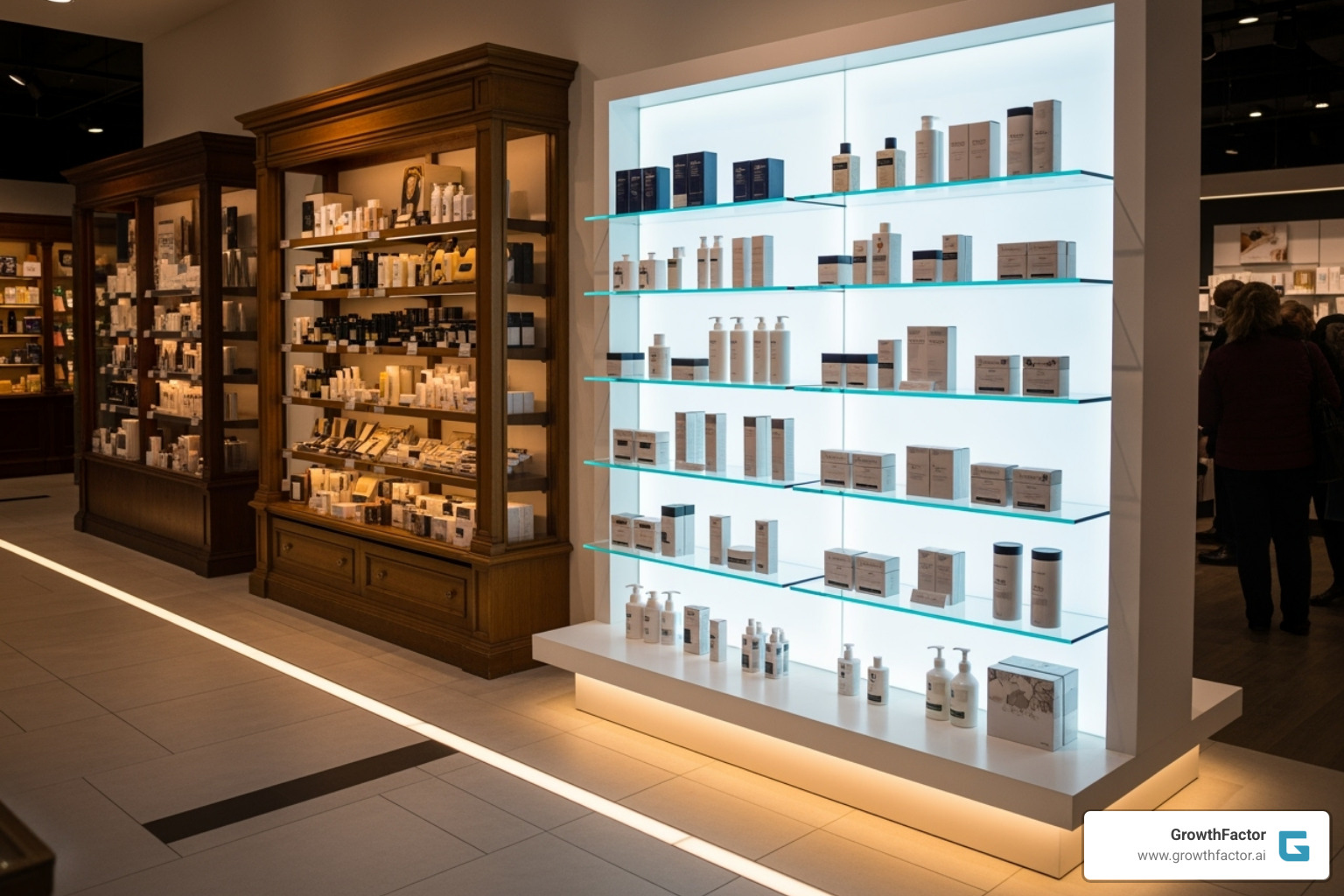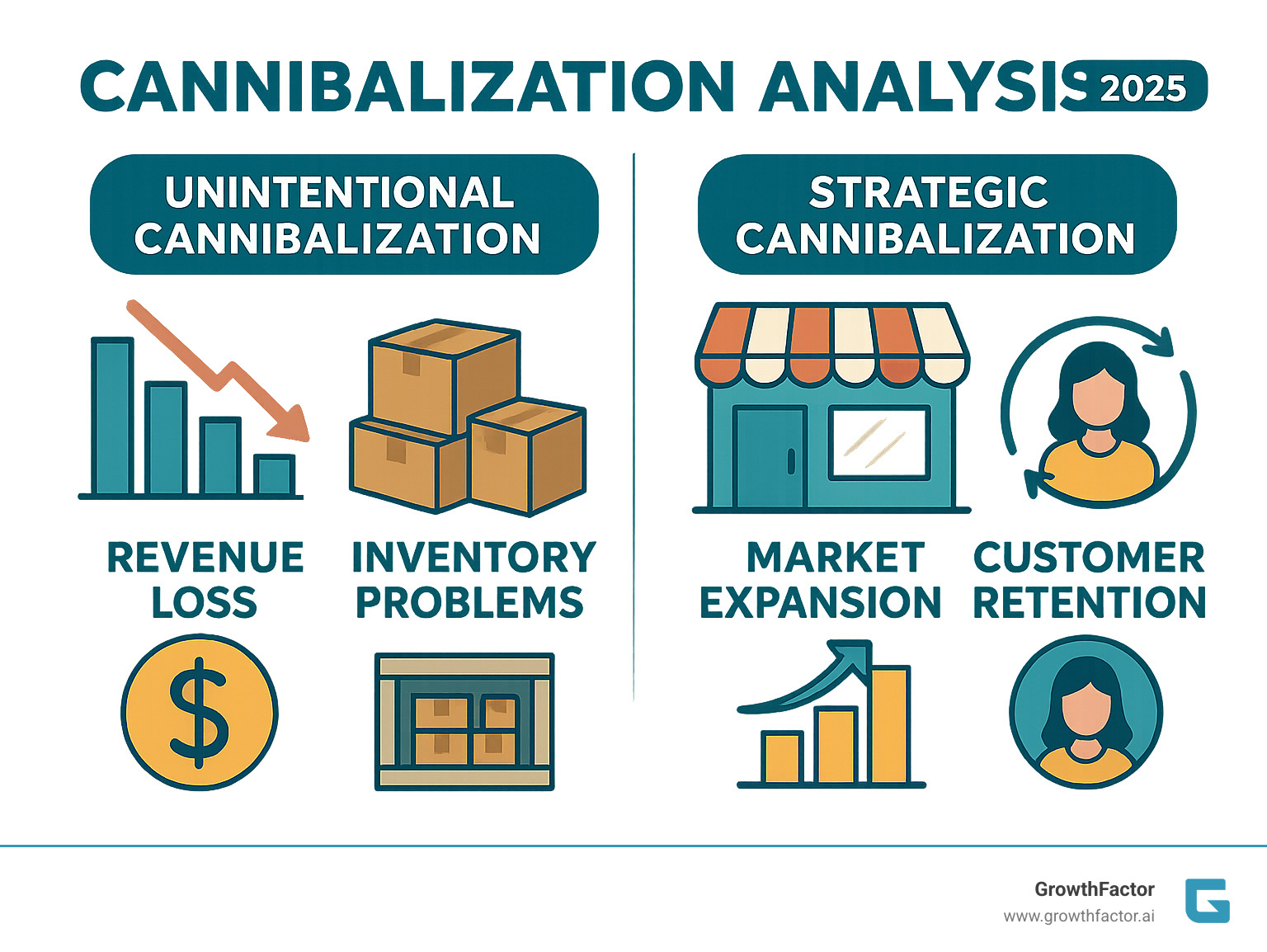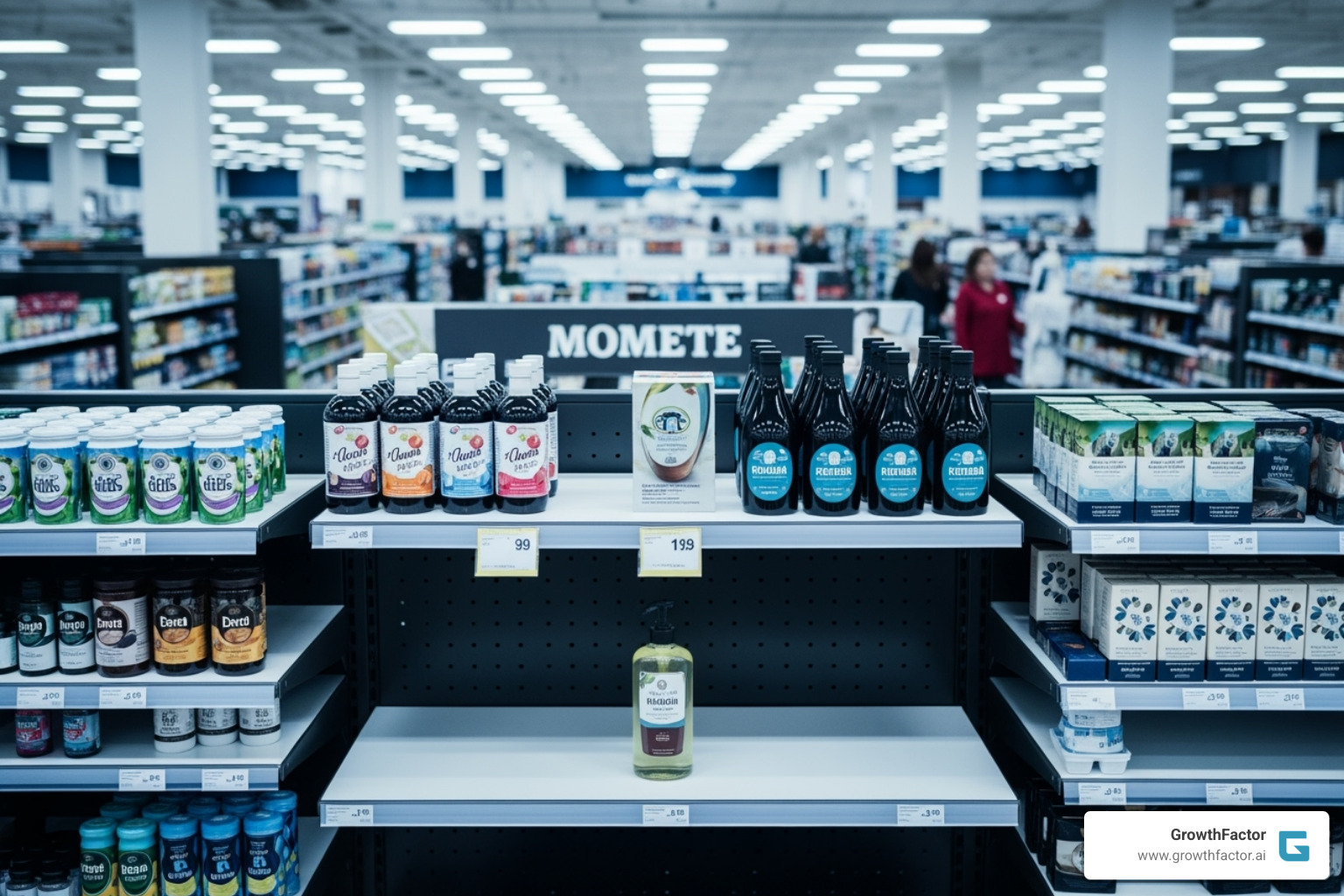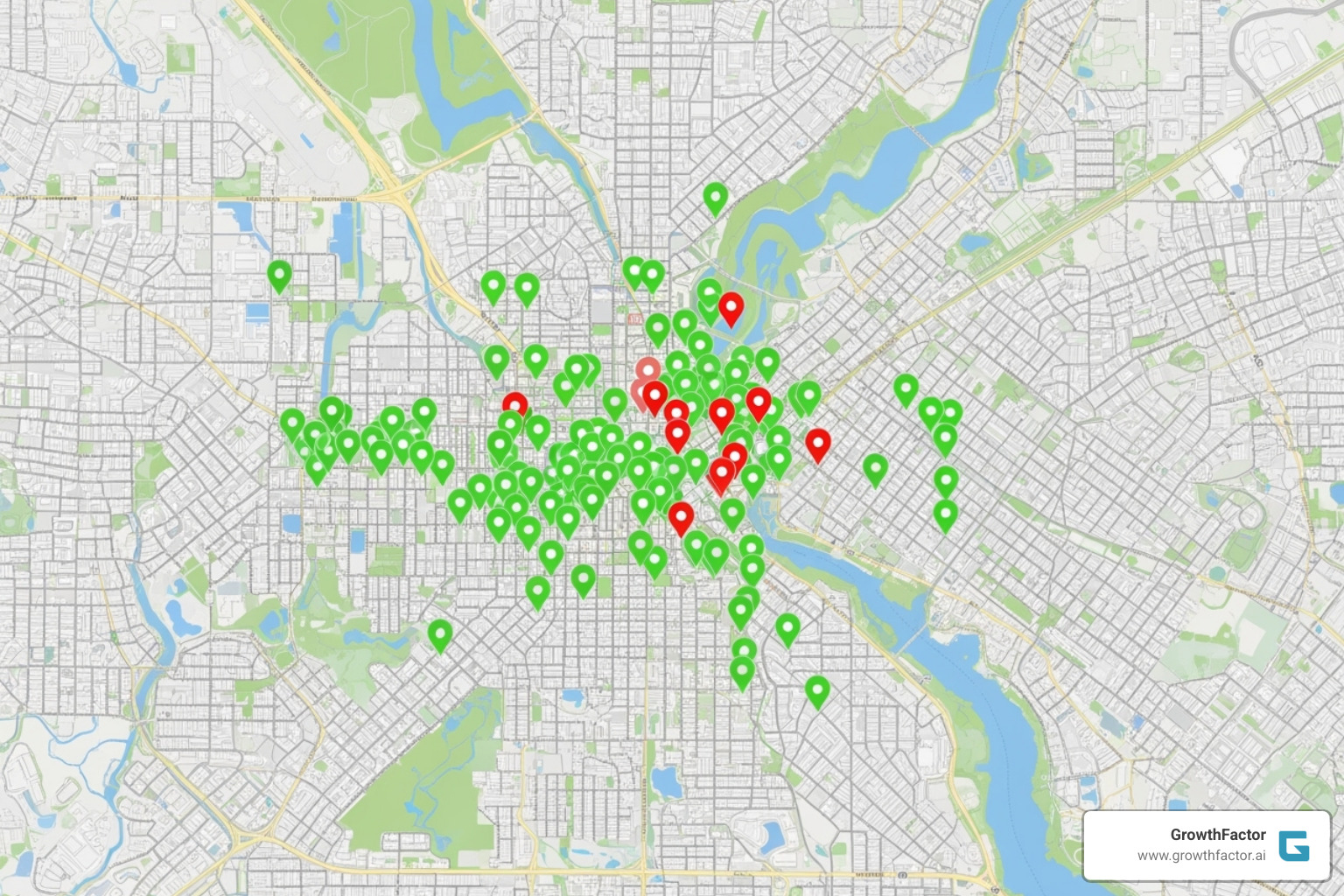Don't Eat Your Own Lunch: Mastering Retail Cannibalization Analysis
Understanding Retail Cannibalization Analysis

Cannibalization analysis retail evaluates how new products or store locations impact a company's existing sales. This analysis helps retailers determine if expansion will generate incremental revenue or merely redistribute existing sales.
Key Components of Retail Cannibalization Analysis:
- Product Cannibalization: New products reducing sales of existing items.
- Location Cannibalization: New stores drawing customers from existing locations.
- Cannibalization Rate: Calculated as (Sales Lost / Sales of New Product or Location) * 100.
- Net Impact: Incremental sales minus cannibalized sales, showing true growth.
Unmanaged cannibalization can devastate growth, leading to lost revenue, inventory imbalances, and costly markdowns to clear excess stock, which erodes profit margins.
However, cannibalization isn't always negative. As Apple founder Steve Jobs said, "If we don't cannibalize ourselves, someone else will." Smart retailers use strategic cannibalization to replace outdated products, enter new markets, and retain customers who might otherwise go to competitors.
The challenge is distinguishing between beneficial strategic cannibalization and damaging unintentional cannibalization. Without proper analysis, retailers risk opening stores that only shift sales instead of growing the business—a costly mistake, especially for fast-growing chains.
I'm Clyde Christian Anderson. At GrowthFactor.ai, I've helped retailers evaluate over 2,000 potential locations using comprehensive cannibalization analysis retail to prevent costly expansion mistakes. My experience ranges from retail operations to developing AI-powered platforms that identify cannibalization risks early.

A Guide to Conducting a Cannibalization Analysis in Retail
Understanding the ripple effects of new initiatives is crucial for managing retail expansion and product innovation. Let's explore how to analyze and manage sales cannibalization.
Identifying the Triggers: What Causes Sales Cannibalization?
The first step in mastering cannibalization analysis retail is understanding its causes. Product cannibalization occurs when a new product pulls demand from existing ones. Similarly, location cannibalization happens when a new store siphons sales from nearby locations.
Key triggers include:
- Pricing Strategy: A new, lower-priced product that is comparable to an existing, higher-priced item will naturally cause customers to switch. This can also happen with discounts, as consumers gravitate toward cheaper alternatives.
- Product Mix and Assortment Planning: Adding new items with trending features can make older products seem redundant. Fashion retailers often see new collections pull sales from last season's items. CPG brands must be wary of new products that simply replace existing demand rather than creating new growth.
- New Product Introduction: This carries an inherent risk of cannibalization, which can be either unintentional or intentional.
- Unintentional Cannibalization: Kodak's economy-brand camera film unintentionally cannibalized its more profitable mainstream brands, leading to the new product's cancellation. This is a classic case of reducing profit without gaining market share.
- Intentional Cannibalization: Conversely, some companies accept cannibalization. Procter & Gamble introduced Tide in the 1940s, which cannibalized its soap brands but ultimately led to market dominance. Apple is a master of this, releasing new iPhones and iPads that supersede older models to keep customers within its ecosystem and ahead of competitors.
Unchecked product cannibalization leads to inventory imbalances and markdowns. At GrowthFactor, we know effective retail location analysis is key to identifying these triggers. Learn more about our approach at More info about retail location analysis.
Calculating the Impact: Key Metrics for Retail Cannibalization Analysis
After identifying triggers, the next step in cannibalization analysis retail is to quantify the impact with hard numbers. We rely on several key metrics to inform strategic decisions.
Essential calculations include:
Cannibalization Rate (%): This shows the percentage of a new product's or location's sales that are pulled from existing offerings.
- For product cannibalization: (Sales Lost on Existing Product / Sales of New Product) * 100.
- For location cannibalization: (Estimated Sales Lost by Existing Store / Existing Store Sales Before New Opening) * 100. A rate above 20% is often considered high.
Incremental Sales: This isolates the true new sales generated after accounting for cannibalization.
- Formula: Estimated New Store or Product Sales – Cannibalized Sales from Existing Stores or Products.
Net Profit Impact: This bottom-line assessment shows the effect on overall company profitability.
- Formula: (Incremental Sales * Profit Margin) – Cannibalization Impact (lost profit from cannibalized sales).
Proximity Overlap (%): For location analysis, this estimates the shared customer base between new and existing stores.
- Formula: (Number of Shared Customers / Total Customers in the Region) * 100.
Performing these calculations requires robust data, including historical sales, geographic and demographic data, foot traffic, and competitor locations.
Here's a sample calculation for a new store:
| Metric | Calculation | Value (Example) |
|---|---|---|
| Existing Store Sales (Before) | $500,000 | |
| Estimated New Store Sales | $300,000 | |
| Estimated Sales Lost by Existing | $75,000 | |
| Cannibalization Rate (%) | ($75,000 / $500,000) * 100 | 15% |
| Incremental Sales | $300,000 - $75,000 | $225,000 |
| Profit Margin | (Assumed) | 25% |
| Cannibalization Impact (Profit) | $75,000 * 0.25 | $18,750 |
| Net Profit Impact | ($225,000 * 0.25) - $18,750 | $37,500 |
These calculations provide the quantitative backbone for informed decisions. GrowthFactor's platform automates this analysis, allowing for rapid impact assessments. Dive deeper into how we use More info about site selection data.
Strategic Cannibalization: Turning a Threat into an Opportunity
While cannibalization analysis retail often focuses on mitigation, strategic cannibalization can be a powerful tool for growth. The goal is to proactively introduce products or locations that might pull existing sales but achieve a greater business objective. As Steve Jobs noted, "If we don't cannibalize ourselves, someone else will."
Ways to leverage strategic cannibalization:
- Market Dominance and Innovation: Introducing a superior product that makes an older one obsolete is key to maintaining market leadership. The tech industry's constant cycle of new smartphones is a prime example of this planned obsolescence keeping customers engaged.
- Replacing Outdated Products: Strategically phase out less profitable inventory by replacing it with new, more appealing selections. This can redirect demand to higher-value products and maximize overall profits.
- Customer Retention and Ecosystem Strategy: Companies like Apple use new products like the iPad or iPhone to keep customers within their ecosystem, even if it impacts sales of Macs or iPods. The goal is to sell a broad, interconnected experience.
- Attracting New Audiences: A lower-priced version of a premium product can attract budget-conscious consumers. As long as the new customers and overall profit impact are positive, it's a strategic win.
Successful strategic cannibalization requires careful planning, market knowledge, and clear product differentiation to ensure you're building new revenue streams, not just shifting them.

This forward-thinking approach is backed by Scientific research on Cannibalization and Complementarity Effects.
Mitigating the Risks of Unintentional Cannibalization
Unintentional cannibalization occurs when a new initiative eats into existing sales without a net positive impact. With careful planning and monitoring, these risks can be significantly mitigated.
Best practices for avoiding unintentional cannibalization analysis retail:
- Thorough Market Research: Before any launch, conduct comprehensive research and testing to preview how new products or stores will perform and interact with existing ones.
- Clear Product Differentiation: Ensure products are sufficiently different. A new item too similar to an existing one, especially at a lower price, creates internal competition. Clearly communicate the unique benefits of each product.
- Strategic Assortment Optimization: Analyze your product assortment by price to identify over-saturation. A balanced assortment offers clear choices without unnecessary internal competition.
- Disciplined Pricing Strategy: Develop a pricing strategy that maintains a competitive balance among products, ensuring each has a distinct value proposition.
- Store Differentiation: If new stores must be close to existing ones, differentiate their offerings or services to cater to different customer segments and reduce direct competition.
- Pilot Testing: Conduct pilot tests in select markets to observe real-world behavior and identify cannibalization issues early, reducing financial risk before a full rollout.
- Continuous Monitoring: After launch, closely monitor sales data to track key metrics like the cannibalization rate. Early identification allows for quick action to recover lost sales.
Proactively addressing these areas ensures new initiatives contribute positively to growth. Our retail expansion planning software is designed to help steer these complexities. Find out how we can help at More info about retail expansion planning.
The Future of Cannibalization Management: AI and Predictive Analytics
The days of hoping a new store won't hurt existing locations are over. Today's cannibalization analysis retail is powered by artificial intelligence and predictive analytics, enabling retailers to forecast impacts before making commitments. Modern AI platforms allow you to simulate major business decisions in a risk-free environment.
The Role of Predictive Analytics in Retail Cannibalization Analysis
Predictive analytics acts as a crystal ball for understanding cannibalization before it happens. Instead of reacting to past sales reports, you can forecast the impact of new products and locations with high accuracy.
AI-powered platforms can simulate thousands of scenarios, modeling how a new location or product line will perform. These models incorporate numerous variables—weather patterns, local events, competitor movements, and seasonal trends—to predict not just sales, but how much of those sales will be cannibalized from existing assets. This leads to more sophisticated demand forecasting and smarter inventory planning.
Scenario planning through AI takes the guesswork out of expansion. You can test different pricing strategies, assortment mixes, and location combinations in a risk-free simulation. This holistic approach to pricing optimizes your entire portfolio to minimize internal competition and maximize overall profitability.

At GrowthFactor, our AI Agent Waldo embodies this approach. Waldo evaluates five times more potential sites than traditional methods, automatically scoring locations based on cannibalization risk and growth potential. Learn more about how More info about AI location intelligence is reshaping site selection.
From Analysis to Action: Integrating Insights into Your Growth Strategy
Understanding cannibalization is only half the battle; the real value comes from turning insights into smart business moves. The most successful retailers act decisively based on what the data tells them.
Data-driven decisions require backing up gut feelings with solid analytics. A high cannibalization rate isn't automatically bad—the key is having all the numbers on incremental sales and profit before making a call. This enables strategic portfolio optimization. Some of our clients have found that closing underperforming stores actually boosted network profitability as sales shifted to more efficient locations.
Smart site selection means looking beyond a single location to understand network effects. The perfect spot is about how it fits into your broader expansion strategy. Will it serve new customers or just redistribute existing ones? Data provides the answer.
GrowthFactor makes this complex analysis accessible and actionable. Our AI Agent Waldo translates findings into clear recommendations for busy executives. We offer scalable plans to fit your business needs, from our Core plan ($500) for essential analysis to our Growth ($1,500) and Enterprise plans for comprehensive network optimization.

The future of retail expansion isn't about avoiding cannibalization—it's about understanding it so well you can turn it into a competitive advantage. When you can predict, measure, and optimize for these effects, every new location becomes a strategic win.
Ready to transform your expansion strategy? Learn how AI can optimize your expansion strategy for retail brands and see what's possible when data meets decision-making.
Citations
The human algorithm
Ready to see what we're cooking?
Submit your information below and we'll be in touch to schedule.







